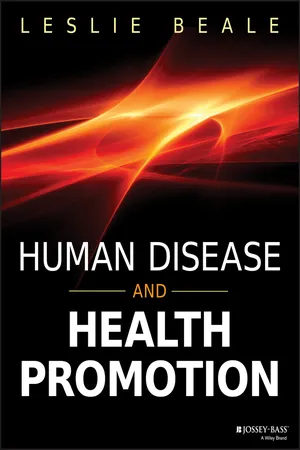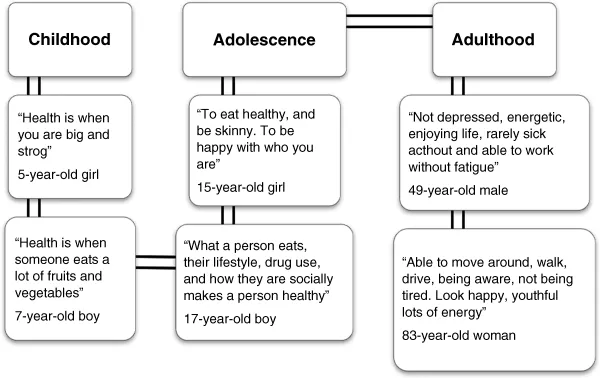
- English
- ePUB (mobile friendly)
- Available on iOS & Android
Human Disease and Health Promotion
About this book
Human Disease and Health Promotion offers a comprehensive introduction to health advocacy and patient education in a real-world context. Covering the epidemiology and pathology of major communicable and non-communicable diseases, this book details up-to-date health promotion strategies and communication approaches designed to engage diverse populations. These methodologies can inform health promotion efforts.
You'll learn how to partner with the patient to navigate healthcare systems and services and how to manage the relationship to avoid patient dependence and advocate burn-out. An extensive guide to common diseases includes details on mechanism, treatment, epidemiology, pathology, and attendant psychosocial implications, and prevention and control are emphasized to the degree that the patient has the capacity to obtain, process, and understand the information and services needed to make appropriate health decisions. Rich in examples, tools, and exercises, this text includes access to a downloadable workbook that provides additional exercises to reinforce concepts and build essential practical skills.
Public health education and advocacy is an enormous undertaking with many variables. This book helps provides a real-world picture of the depth and breadth of the field, with clear guidance toward current theory and practice.
- Apply current health literacy theories and participatory patient education strategies
- Design, implement, and evaluate programs targeting various groups
- Analyze and apply new technologies in patient education and health advocacy
- Understand the mechanisms, treatments, and epidemiology of common diseases
Nine out of ten adults may lack the skills needed to manage their health and prevent disease, and over half find it a challenge to self-manage chronic diseases and use health services appropriately. Human Disease and Health Promotion helps you develop your role as health educator and advocate so you can connect patients with the care and information they need.
Frequently asked questions
- Essential is ideal for learners and professionals who enjoy exploring a wide range of subjects. Access the Essential Library with 800,000+ trusted titles and best-sellers across business, personal growth, and the humanities. Includes unlimited reading time and Standard Read Aloud voice.
- Complete: Perfect for advanced learners and researchers needing full, unrestricted access. Unlock 1.4M+ books across hundreds of subjects, including academic and specialized titles. The Complete Plan also includes advanced features like Premium Read Aloud and Research Assistant.
Please note we cannot support devices running on iOS 13 and Android 7 or earlier. Learn more about using the app.
Information
Part 1
Foundations of Human Health and Health Promotion
Chapter 1
Overview of Health
Chapter Outline
- Health Defined
- Two Aspects of Health: Physical and Mental
- Wellness Defined
- Risk and Protective Factors That Influence Health
- Health Determinants
- The Three P's: Population, Poverty, and Pollution
- Health as a Basic Human Right
- Chapter Summary
- Review Questions
- Key Terms
- Chapter Activities
- Bibliography and Works Cited
Chapter Objectives
- ♦ Define health and wellness.
- ♦ Identify the two aspects of health: physical and mental.
- ♦ Describe and give examples of health determinants.
- ♦ Compare and contrast risk factors and protective factors that influence health.
- ♦ Explain how the three P's—population, poverty, and pollution—influence health.
- ♦ Summarize why health is a basic human right.
Health Defined
- Culture differences Purnell (2003) expands the WHO 1948 and 1986 definitions by adding that health is “a state of wellness that includes physical, mental, and spiritual states and is defined by individuals within their cultural group.”
- Age differences Older adults may define health as mobility and independence. Middle-aged adults may define health as an inner strength and the ability to handle life's challenges. Young adults and adolescents may define health as good physical condition, energy, and personal attractiveness. Children may define health as physical strength. In other words, views of health change as we grow older. Health across the lifespan means that physical, mental, and social factors are interconnected and that health is a life-course process that requires a changing definition as we age (Manderscheid et al., 2010) (see Figure 1.1).
- Gender differences The different roles for men and women have negative as well as positive impacts on health. Work, parenthood, marriage, and aging, for example, create gender-specific physiological and psychological stresses that affect health.
- Socioeconomic status (SES) Those who have a high SES may view health as enjoying life, and those who have a low SES may view health as meeting basic needs of food, shelter, and safety.

Two Aspects of Health: Physical and Mental
our emotional, psychological, and social wel...
Table of contents
- Cover
- Title Page
- Copyright
- Dedication
- Introduction
- Preface
- Acknowledgments
- About the Author
- Part 1: Foundations of Human Health and Health Promotion
- Part 2: Human Diseases from a Systemic Approach
- Index
- End User License Agreement